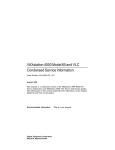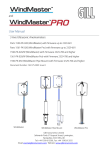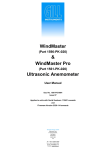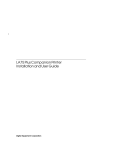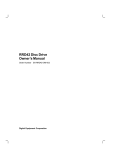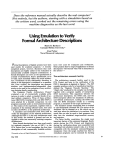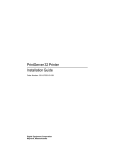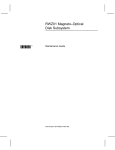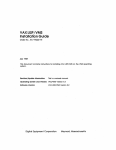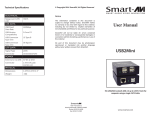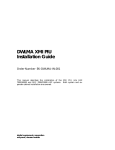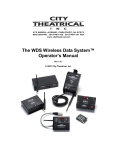Download BA46 Expansion Box Service Information
Transcript
dt BA46 Storage Expansion Box Service Information EK-VBA46-SV.001 Digital Equipment Corporation Maynard, Massachusetts First Edition, February 1992 The information in this document is subject to change without notice and should not be construed as a commitment by Digital Equipment Corporation. Digital Equipment Corporation assumes no responsibility for any errors that may appear in this document. The software described in this document is furnished under a license and may be used or copied only in accordance with the terms of such license. No responsibility is assumed for the use or reliability of software on equipment that is not supplied by Digital Equipment Corporation or its affiliated companies. Restricted Rights: Use, duplication, or disclosure by the U. S. Government is subject to restrictions as set forth in subparagraph ( c ) ( 1 ) ( ii ) of the Rights in Technical Data and Computer Software clause at DFARS 252.227–7013. Copyright © by Digital Equipment Corporation 1992 All Rights Reserved. Printed in U.S.A. The following are trademarks of Digital Equipment Corporation: DEC, Digital, VAX, VMS, and the DIGITAL logo. This document was prepared using VAX DOCUMENT, Version 2.0. Contents Preface 1 vii BA46 Storage Expansion Box 1.1 Overview . . . . . . . . . . . . . . . . . . . . . . . . . . . . . . . . . . . . . . . . 1.1.1 Specifications . . . . . . . . . . . . . . . . . . . . . . . . . . . . . . . . . . . 1.2 SCSI ID Settings . . . . . . . . . . . . . . . . . . . . . . . . . . . . . . . . . . 2 Mass Storage Devices 2.1 2.1.1 2.2 2.2.1 2.3 2.3.1 2.4 2.4.1 2.5 2.5.1 3 1–1 1–4 1–5 RZ5x Hard Disk Drives . . . . . . . . . . . . . . . . . . . . . . . . . . . . . 2–2 SCSI ID Settings for RZ5x Hard Disk Drives . . . . . . . . . . 2–2 TLZ04 Cassette Tape Drive . . . . . . . . . . . . . . . . . . . . . . . . . . 2–4 SCSI ID Settings for the TLZ04 Tape Drive . . . . . . . . . . . . 2–4 TZ30 Cartridge Tape Drive . . . . . . . . . . . . . . . . . . . . . . . . . . 2–6 SCSI ID Settings for the TZ30 Cartridge Tape Drive . . . . . 2–6 TZK10 (QIC) Cartridge Tape Drive . . . . . . . . . . . . . . . . . . . . 2–8 SCSI ID Settings for the TZK10 Tape Drive . . . . . . . . . . . 2–8 RRD42 CDROM Disc Drive . . . . . . . . . . . . . . . . . . . . . . . . . . 2–10 SCSI ID Settings for the RRD42 CDROM Drive . . . . . . . . 2–10 FRU Removal and Replacement 3.1 3.2 3.3 3.4 3.4.1 3.4.2 3.5 3.5.1 3.5.2 3.5.3 Precautions . . . . . . . . . . . . . . . . . . . . . . . . . . . . BA46 Expansion Box Part Numbers . . . . . . . . . System Preparation . . . . . . . . . . . . . . . . . . . . . . Front Bezel . . . . . . . . . . . . . . . . . . . . . . . . . . . . Bezel Removal . . . . . . . . . . . . . . . . . . . . . . . . Bezel Replacement . . . . . . . . . . . . . . . . . . . . . Mass Storage Device Removal and Replacement Getting Started . . . . . . . . . . . . . . . . . . . . . . . RZ5x Hard Disk Drive Removal . . . . . . . . . . . RZ5x Hard Disk Drive Replacement . . . . . . . . . . . . . . . . . . . . . . . . . . . . . . . . . . . . . . . . . . . . . . . . . . . . . . . . . . . . . . . . . . . . . . . . . . . . . . . . . . . . . . . . . . . . . . . . . . 3–2 . 3–2 . 3–6 . 3–7 . 3–7 . 3–7 . 3–8 . 3–8 . 3–9 . 3–10 iii iv Contents 3.5.4 RRD42 CDROM Drive Removal . . . . . . . . . . . . . . . . . 3.5.5 RRD42 CDROM Drive Replacement . . . . . . . . . . . . . 3.5.6 TZ30 Cartridge Tape Drive Removal . . . . . . . . . . . . . 3.5.7 TZ30 Cartridge Tape Drive Replacement . . . . . . . . . . 3.5.8 TLZ04 Cassette Tape Drive Removal . . . . . . . . . . . . . 3.5.9 TLZ04 Cassette Tape Drive Replacement . . . . . . . . . . 3.5.10 TZK10 (QIC) Cartridge Tape Drive Removal . . . . . . . 3.5.11 TZK10 (QIC) Cartridge Tape Drive Replacement . . . . 3.6 Power Supply . . . . . . . . . . . . . . . . . . . . . . . . . . . . . . . . . 3.6.1 Power Supply Removal . . . . . . . . . . . . . . . . . . . . . . . 3.6.2 Power Supply Replacement . . . . . . . . . . . . . . . . . . . . 3.7 Load Module . . . . . . . . . . . . . . . . . . . . . . . . . . . . . . . . . 3.7.1 Load Module Removal . . . . . . . . . . . . . . . . . . . . . . . . 3.7.2 Load Module Replacement . . . . . . . . . . . . . . . . . . . . . 3.8 Restoring the Expansion Box . . . . . . . . . . . . . . . . . . . . . 3.9 Testing the System and Expansion Box After Adding a Device . . . . . . . . . . . . . . . . . . . . . . . . . . . . . . . . . . . . . . 4 . . . . . . . . . . . . . . . . . . . . . . . . . . . . . . . . . . . . . . . . . . . . . . . . . . . . . . . . . . . . 3–12 3–13 3–13 3–14 3–15 3–16 3–17 3–17 3–18 3–18 3–18 3–19 3–19 3–19 3–20 . . . . 3–21 Preventive Maintenance and Problem Solving 4.1 TLZ04 Cassette Tape Drive Preventive Maintenance . 4.2 Problem Solving . . . . . . . . . . . . . . . . . . . . . . . . . . . . . 4.2.1 RZ5x Hard Disk Drives . . . . . . . . . . . . . . . . . . . . . 4.2.2 TLZ04 Cassette Tape Drive . . . . . . . . . . . . . . . . . . 4.2.3 TZ30 Cartridge Tape Drive . . . . . . . . . . . . . . . . . . 4.2.4 TZK10 Cartridge Tape Drive . . . . . . . . . . . . . . . . . 4.2.5 RRD42 Compact Disc Drive . . . . . . . . . . . . . . . . . . 4.2.6 Power Supply . . . . . . . . . . . . . . . . . . . . . . . . . . . . . Index . . . . . . . . . . . . . . . . . . . . . . . . . . . . . . . . . . . . . . . . . . . . . . . . 4–2 4–3 4–3 4–4 4–5 4–6 4–7 4–7 Contents v Figures 1–1 1–2 2–1 2–2 2–3 2–4 3–1 3–2 3–3 BA46 Storage Expansion Box . . . . . . . . . . . . . . . SCSI Switch Location for RZ5x Disk Drives . . . TLZ04 Tape Drive SCSI ID Switch Location . . . TZ30 Tape Drive SCSI ID Switch Location . . . . TZK10 SCSI ID Jumper Location . . . . . . . . . . . RRD42 SCSI ID Jumper Location . . . . . . . . . . . Expansion Box FRUs . . . . . . . . . . . . . . . . . . . . . RZ5x Hard Disk Drive SCSI ID Cable Location . RZ5x Disk Drive SCSI ID Jumper Location . . . . . . . . . . . . . . . . . . . . . . . . . . . . . . . . . . . . . . . . . . . . . . . . . . . . . . . . . . . . . . . . . . . . . . . . . . . . . . . . . . . . . . 1–2 . 1–7 . 2–4 . 2–6 . 2–9 . 2–11 . 3–5 . 3–9 . 3–11 Optional Drives . . . . . . . . . . . . . . . . . . . . . . . . . . . . . Electrical Requirements . . . . . . . . . . . . . . . . . . . . . . . Operating Environment . . . . . . . . . . . . . . . . . . . . . . . Physical Dimensions . . . . . . . . . . . . . . . . . . . . . . . . . Device IDs for SCSI Devices . . . . . . . . . . . . . . . . . . . RZ5x Hard Disk Drive SCSI ID Switch Settings . . . . TLZ04 Cassette Tape Drive SCSI ID Switch Settings Setting the TZ30 Tape Cartridge Drive SCSI ID . . . . RRD42 CDROM Drive Jumper Settings . . . . . . . . . . . FRUs and Part Numbers . . . . . . . . . . . . . . . . . . . . . . Cables and Part Numbers . . . . . . . . . . . . . . . . . . . . . Miscellaneous Hardware and Part Numbers . . . . . . . RZ5x Hard Disk Drive Problem Solving . . . . . . . . . . . TLZ04 Cassette Tape Drive Problem Solving . . . . . . . TZ30 Cartridge Tape Drive Problem Solving . . . . . . . TZK10 Cartridge Tape Drive Problem Solving . . . . . . RRD42 Compact Disc Drive Problem Solving . . . . . . . Power Supply Problem Solving . . . . . . . . . . . . . . . . . . . . . . . . . . . . . . . . . . . . . . . . . . . . . . . . . . . . . . . . . . . . . . . . . . . . . . . . . . . . . . . . . . . . . . . . . . . . . . . . . . . . . . . . . . . . 1–3 . 1–4 . 1–4 . 1–5 . 1–6 . 2–3 . 2–5 . 2–7 . 2–11 . 3–3 . 3–4 . 3–4 . 4–3 . 4–4 . 4–5 . 4–6 . 4–7 . 4–7 Tables 1–1 1–2 1–3 1–4 1–5 2–1 2–2 2–3 2–4 3–1 3–2 3–3 4–1 4–2 4–3 4–4 4–5 4–6 Preface This manual is a support and reference document for Digital Services personnel who perform maintenance work on Digital workstations. It is also for Digital customers who have a self-maintenance agreement with Digital. Manual Organization The contents of this manual are organized as follows: • Chapter 1 provides an overview of the BA46 Storage Expansion Box and describes the box’s mass storage areas and operating requirements. • Chapter 2 describes mass storage devices that can be configured in the expansion box, and provides SCSI ID settings for the devices. • Chapter 3 provides information for removing and replacing field replaceable units (FRUs). • Chapter 4 provides information about maintaining and troubleshooting the expansion box. Related Documentation The following documents provide additional information about the expansion box and the VAXstation 4000 Model 60 workstation, which uses the BA46 Storage Expansion Box as its system box. Document Part Number BA46 Storage Expansion Box Owner’s Guide EK-STEXP-IG VAXstation 4000 Service Information Kit Guide EK-V466H-SV-001 VAXstation 4000 Model 60 Quick Installation Guide EK-PMARI-IN VAXstation 4000 Model 60 Owner’s and System Installation Guide EK-PMARI-OM vii viii Preface Document Part Number VAXstation 4000 Model 60 Service Information EK-V466B-SV-001 VAXstation 4000 Model 60 Pocket Service Information EK-V466H-PS-001 VAXstation 4000 Model 60 Optional Devices Service Information EK-V4066-SV-001 Conventions The following conventions are used in this guide. Convention Description WARNING Contains important information that relate to personal safety. CAUTION Contains information to prevent damage to the equipment. NOTE Contains general information. PN Part number 1 BA46 Storage Expansion Box This chapter describes the BA46 Storage Expansion Box, its configurations, and operating requirements, and SCSI ID settings for mass storage devices. This chapter is organized into the following sections: Section 1.1 Overview Section 1.1.1 Specifications Section 1.2 SCSI ID Settings 1.1 Overview The BA46 Storage Expansion Box is an external box that connects to a system unit to provide additional disks or other small computer system interface (SCSI) devices. Figure 1–1 shows an exploded view of the expansion box and its components. 1–1 1–2 BA46 Storage Expansion Box Figure 1–1 BA46 Storage Expansion Box The expansion box has two mounting areas for configuring optional drives. Mounting area A is located in the box to the left of the bezel. Mounting area B/C is located in the box directly behind the bezel. The box has an H7819-AA power supply that provides dc power to the drives. Table 1–1 lists the devices available for the expansion box and gives their storage capabilities. BA46 Storage Expansion Box 1–3 Table 1–1 Optional Drives Drive Type Size Storage Capacity RZ55 Hard disk 5.25 in 332 Mbyte RZ56/57 Hard disk 5.25 in 600 Mbyte TLZ04 Cassette tape 5.25 in 1.2 Gbyte TZ30 Cartridge tape 3.5 in 95 Mbyte TZK10 (QIC) Cartridge tape 3.5 in 525 Mbyte RRD42 CDROM Compact disc 3.5 in 600 Mbyte The expansion box can be configured with two full-height storage devices or with one full-height storage device and two half-height storage devices. Mounting areas A and B/C can be individually configured with the drives listed in the following sections. Mounting Area A Configuration Mounting area A does not allow external access and is used to mount full-height drives only. The mounting area could also be empty. • RZ55 Full-Height hard disk drive • RZ56/57 Full-Height hard disk drive Mounting Area B/C Configuration Mounting area B/C allows for external access and can be used to mount one or two half-height drives or one full-height drive. • RZ56/57 Full-Height hard disk drive • TLZ04 Full-Height cassette tape drive • RRD42 Half-Height compact disc drive • TZ30 Half-Height cartridge tape drive • TZK10 Half-Height cartridge tape drive 1–4 BA46 Storage Expansion Box 1.1.1 Specifications The expansion box specifications for electrical requirements and the operating environment, and its physical dimensions are given in the following tables. Table 1–2 Electrical Requirements Input voltage 100 Vac to 120 Vac, auto voltage select 220 Vac to 240 Vac, auto voltage select Frequency range 47 to 63 Hz Table 1–3 Operating Environment Temperature range 15° C to 32° C (59° F to 90° F) Maximum rate of temperature change 11° C to 20° C (20° F) per hour Relative humidity 20% to 80% (with tape) Altitude 0 to 2400 m (0 to 8000 ft) Maximum wet bulb temperature 28° C (82° F) Minimum dew point 2° C (36° F) BA46 Storage Expansion Box 1–5 Table 1–4 Physical Dimensions Height Width Depth Weight1 1.7 cm (4.3 in) 7.4 cm (19.0 in) 6.0 cm (15.5 in) 15.9 kg (35 lb) 1 Includes two RZ5x drives in the expansion box. For additional information about the expansion box, refer to the BA46 Storage Expansion Box Owner’s Guide (EK-STEXP-IG). 1.2 SCSI ID Settings The small computer systems interface (SCSI) connects disk drives and other peripheral devices to computer systems. As many as eight SCSI devices can share a SCSI bus. All data is sent between the system and the devices on the cable. Each of the eight SCSI devices is identified by a number from 0 to 7, called a SCSI ID. Each device looks at all the data on the bus, but takes only the data that has the correct SCSI identification. SCSI ID 6 is reserved for the host controller, leaving seven SCSI ID numbers available to identify SCSI devices. SCSI default settings for each expansion box are listed in Table 1–5. The settings listed give optimal performance on most systems. However, for most applications, SCSI IDs can be set arbitrarily as long as no two devices have the same ID. 1–6 BA46 Storage Expansion Box Each device has either a set of switches or a set of jumpers (removable electrical connectors) that can be set for a specific ID. The RZ5x disk drives use external switches on the back of the expansion box (see Figure 1–2 ). Use the following rules when setting SCSI IDs: • As many as seven devices can be connected on one bus. • As many as three expansion boxes can be connected on one bus. • Each device must have a unique SCSI ID. • The length of the SCSI bus cannot be more than 4 meters (13 ft). Table 1–5 lists the recommended SCSI ID numbers for the drives. Table 1–5 Device IDs for SCSI Devices ID Number Type of SCSI Device 7 Open number, may be used for any drive 6 Reserved as the system controller ID 5 Tape/Floppy drives, factory configured 4 CDROM drive, factory configured 3 Hard disk drive, factory configured first disk 2 Hard disk drive, factory configured second disk 1 Hard disk drive, factory configured third disk 0 Hard disk drive, factory configured fourth disk Each expansion box with an RZ56/RZ57 disk drive ships from the factory with the SCSI switches (Figure 1–2) set for one or two of these devices. Verify the switch settings when you install the expansion box. BA46 Storage Expansion Box 1–7 Figure 1–2 SCSI Switch Location for RZ5x Disk Drives SCSI ID Switches MLO-005139 Chapter 2 describes each of the mass storage devices in further detail and lists the SCSI ID settings for each one. 2 Mass Storage Devices This chapter describes the optional mass storage devices that can be installed in the BA46 expansion box, and provides the SCSI ID settings that should be used for each device. The chapter is organized into the following sections: Section 2.1 RZ5x Hard Disk Drives Section 2.2 TLZ04 Cassette Tape Drive Section 2.3 TZ30 Cartridge Tape Drive Section 2.4 TZK10 (QIC) Cartridge Tape Drive Section 2.5 RRD42 CDROM Compact Disc Drive Refer to Chapter 3 for removal and replacement procedures for the devices. 2–1 2–2 Mass Storage Devices 2.1 RZ5x Hard Disk Drives The RZ55 whole disk drive is a full-height drive with a storage capacity of 332 Mbytes. The RZ56/RZ57 hard disk drives are full-height drives with a storage capacity of 600 Mbytes. These drives store information on a nonremovable disk. 2.1.1 SCSI ID Settings for RZ5x Hard Disk Drives To verify the SCSI ID switch setting for the RZ5x drives, turn the expansion box with the back of the unit facing you. The switches (Figure 1–2) are red and white, and surrounded by a label (do not remove the label). If there is one RZ5x installed in the expansion box, the right three SCSI ID switches on the back of the box determine the SCSI ID switch setting for that drive. If there are two RZ5x disk drives installed in the expansion box, the left three SCSI ID switches on the back of the box determine the SCSI ID switch setting for the second RZ5x disk drive. Verify the SCSI switch settings for the RZ5x drives before you install the drive. 1. Verify that the switches are in the following positions (left to right): DOWN, UP, UP1 . The RZ5x disk drive ships from the factory with a default SCSI ID of 3. 2. Check the SCSI ID settings of all devices connected to the system and choose an unused ID for the new drive. If a drive is being replaced, the SCSI ID from the drive it is replacing should be used. Table 2–1 lists the SCSI ID switch settings for the RZ5x disk drives. 1 UP = on, DOWN = off Mass Storage Devices 2–3 Table 2–1 RZ5x Hard Disk Drive SCSI ID Switch Settings SCSI ID on SCSI-B Bus 1 2 3 0 DOWN DOWN DOWN 1 DOWN DOWN UP 2 DOWN UP DOWN 3 DOWN UP UP 4 UP DOWN DOWN 5 UP DOWN UP 6 UP UP DOWN 7 UP UP UP 2–4 Mass Storage Devices 2.2 TLZ04 Cassette Tape Drive The TLZ04 cassette tape drive can be used for software backup. The TLZ04 drive is a full-height drive and uses cassettes with a storage capacity of 1.2 Gbytes. 2.2.1 SCSI ID Settings for the TLZ04 Tape Drive Verify the SCSI ID switch settings for the TLZ04 drive before you install the drive (Figure 2–1). 1. Turn the TLZ04 drive so that the rear of the drive is facing you. The SCSI ID switches P, 4, 2, 1 are located on the top right corner of the drive. Figure 2–1 TLZ04 Tape Drive SCSI ID Switch Location Parity 4 2 1 MLO-005776 Mass Storage Devices 2–5 2. Make sure the switches are set to the following positions (right to left) for SCSI ID 5: Switch 1 = Up (attached) Switch 2 = Down (removed) Switch 4 = Up (attached) Parity = Down (removed) NOTE Save any switches you remove for future use. Table 2–2 lists the SCSI ID switch settings1 for the TLZ04 tape drive. Table 2–2 TLZ04 Cassette Tape Drive SCSI ID Switch Settings SCSI ID P 4 2 1 0 Down2 Down Down Down 1 Down Down Down Up 2 Down Down Up Down 3 Down Down Up Up 4 Down Up Down Down 3 Down Up Down Up 4 Down Up Up Down Down Up Up Up 5 6 7 2 P=Parity switch is always set to 0 (Up) 3 Recommended 4 Reserved 1 ID for the TLZ04 cassette tape drive ID for SCSI controller Down=0; Up=1 2–6 Mass Storage Devices 2.3 TZ30 Cartridge Tape Drive The TZ30 cartridge tape drive is a half-height drive that can be used for software backups. The TZ30 tape drive has a storage capacity of 95 Mbytes. 2.3.1 SCSI ID Settings for the TZ30 Cartridge Tape Drive When installing a TZ30 tape drive in the expansion box, verify the drive’s SCSI ID switch setting. 1. Locate the SCSI ID switches 1, 2, 3, and 4 on the drive (Figure 2–2). Figure 2–2 TZ30 Tape Drive SCSI ID Switch Location TZ30 TOP RIGHT SIDE FRONT ON SCSI ID BIT:0 SCSI ID BIT:1 SCSI ID BIT:2 SCSI PARITY ENABLE/ DISABLE OFF 4 3 2 1 ON OFF EXAMPLE OF SCSI ID SET TO 5 WITH PARITY ON. MA-X1084-88 2. Use a pen or a small pointed object to move the switches to the ON or OFF position. Mass Storage Devices 2–7 Digital recommends that the TZ30 SCSI ID be set to 5 (Figure 2–2 ): Switch Switch Switch Switch 4 3 2 1 = = = = ON (left position) OFF (right position) ON (left position) ON (left position) Table 2–3 lists the switch settings for the TZ30 tape drive. Table 2–3 Setting the TZ30 Tape Cartridge Drive SCSI ID SCSI ID 1 2 3 4 0 OFF OFF OFF OFF 1 OFF OFF OFF ON 2 OFF OFF ON OFF 3 OFF OFF ON ON 4 OFF ON OFF OFF 5 OFF ON OFF ON 6 OFF ON ON OFF 7 OFF ON ON ON 2–8 Mass Storage Devices 2.4 TZK10 (QIC) Cartridge Tape Drive The TZK10 tape drive is a half-height, 5.25 inch, streaming tape drive. It uses a standard quarter-inch cartridge (QIC). The TZK10 tape drive provides archival storage/retrieval and data collection capabilities. It is also SCSI compatible. The TZK10 drive’s only main component is the drive. The controller logic is located within the drive itself. 2.4.1 SCSI ID Settings for the TZK10 Tape Drive When installing the TZK10 tape drive in the BA46 expansion box, verify the drive SCSI ID jumper settings. The SCSI ID jumpers are located on the rear of the drive, as shown in Figure 2–3. Digital recommends that you set the TZK10 SCSI ID to 5. The jumpers should be set as follows for SCSI ID 5: Jumper 0 = IN (attached) Jumper 1 = Out (removed) Jumper 2 = In (attached) Parity = In (attached) Mass Storage Devices 2–9 Figure 2–3 TZK10 SCSI ID Jumper Location Parity 2 1 0 MLO-006156 2–10 Mass Storage Devices 2.5 RRD42 CDROM Disc Drive The RRD42 compact disc drive is a 600-Mbyte optical drive that allows you to install the VMS operating system and other software onto the system. The RRD42 drive also allows access to read-only databases, such as online documentation sets, and it has audio playback capabilities. 2.5.1 SCSI ID Settings for the RRD42 CDROM Drive When installing an RRD42 CDROM compact disc drive in the expansion box, be sure to verify the SCSI ID settings on the drive. To verify the SCSI ID setting: 1. Turn the drive so that the back of the drive is facing you. Locate the SCSI ID jumpers 0, 1, and 2, on the left side of the drive (Figure 2–4). 2. Verify that the jumpers are set to the following positions (left to right) for SCSI ID 4: Mode = In (attached) 0 = In (attached) 1 = Off (removed) 2 = Off (removed) To set the jumper to the OFF position, remove a jumper from its seating. To set a jumper to the ON position, leave it in place. NOTE Save any jumpers you remove for future use. Mass Storage Devices 2–11 Figure 2–4 RRD42 SCSI ID Jumper Location L GND 5V+5% R AUDIO OUT MODE 0 1 GND 12V+10% DC INPUT 2 ID SELECT FRAME GROUND TAB SCSI BUS INTERFACE CONNECTOR POWER−IN CONNECTOR SHR−XR0064−90 Table 2–4 lists the jumper settings for the RRD42 CDROM disc drive. Table 2–4 RRD42 CDROM Drive Jumper Settings SCSI ID Mode 0 1 2 0 ON OFF OFF OFF 1 ON OFF OFF ON 2 ON OFF ON OFF 3 ON OFF ON ON 4 ON ON OFF OFF 5 ON ON OFF ON 6 ON ON ON OFF 7 ON ON ON ON 3 FRU Removal and Replacement This chapter describes how to remove and replace the field replaceable units (FRUs) in the BA46 expansion box. Only qualified Digital Services personnel or technicians trained by Digital should remove or install FRUs. This chapter is organized into the following sections: Section 3.1 Precautions Section 3.2 BA46 Expansion Box Part Numbers Section 3.3 System Preparation Section 3.4 Front Bezel Removal and Replacement Section 3.5 Mass Storage Device Removal and Replacement Section 3.6 Power Supply Removal and Replacement Section 3.7 Load Module Removal and Replacement Section 3.8 Restoring the Expansion Box 3–1 3–2 FRU Removal and Replacement 3.1 Precautions NOTE It is the customer’s responsibility to back up the software before Digital Services personnel arrive at the customer’s site. This is important to ensure that data is not lost during the service process. The customer should also shut down the workstation software. Before performing any maintenance work, confirm that both of these tasks have been completed. CAUTION Static electricity can damage integrated circuits. Always use a grounded wrist strap (part number 29-11762-00) and a worksurface-to-earth ground when working with the internal parts of the workstation. 3.2 BA46 Expansion Box Part Numbers The following tables provide part numbers for the FRUs, cables, and miscellaneous hardware for the BA46 expansion box. FRU Removal and Replacement 3–3 Table 3–1 FRUs and Part Numbers FRU Part Number Power supply H-7819-AA Expansion Box SCSI ID Select Switch Module 54-19325-02 Expansion Box Load Board 54-20422-01 Front Bezel for 5.25 in Drive 70-28099-02 Front Bezel for 3.5 in Drive 70-28099-03 Front Bezel, Blank 70-28099-01 RRD42 CD ROM Reader RRD42-AA RZ55 Whole Disk Drive RZ55-E RZ56 PCB 29-27889-01 RZ56 HDA 29-27890-01 RZ57 PCB 29-28159-01 RZ57 HDA 70-28158-01 TLZ04 Cassette Tape Drive TLZ04-GG TZ30 Cartridge Tape Drive TZ30-AX TZK10 QIC Cartridge Tape Drive TZK10-AA 3.5 in Half-Height Plastic Mounting Bracket 74-40429-01 5.25 in Half-Height Plastic Mounting Bracket 74-40430-01 Dual Half-Height Metal Mounting Bracket 74-40431-01 3–4 FRU Removal and Replacement Table 3–2 Cables and Part Numbers Cable Part Number Expansion Box SCSI ID Select Cable 17-02445-01 Expansion Box Wire Harness Power Cable 17-02876-02 Expansion Box Internal SCSI Data Cable 70-28109-01 Table 3–3 Miscellaneous Hardware and Part Numbers Item Part Number Diagnostic Port Cover 74-42419-01 Rear Opening RFI Shield Filler 74-41473-01 Filler Plate 74-41472-01 Figure 3–1 shows an exploded view of the expansion box and its FRUs. FRU Removal and Replacement 3–5 Figure 3–1 Expansion Box FRUs 3–6 FRU Removal and Replacement 3.3 System Preparation Do the following to prepare the system for removing or replacing FRUs: 1. Enter console mode by pressing the halt button. Refer to the system manual for the halt button location. 2. Review the current expansion box configuration before replacing a device. After replacing the device, compare the new configuration with the previous one to help verify that all devices are present and functioning correctly. Record the new expansion box configuration information for reference. 3. Turn power off (0) to the expansion box, printer or other equipment, and the system box. 4. Disconnect the system power cord and the expansion box power cord from the wall outlet. 5. Disconnect the SCSI cable from the expansion box. 6. Release the two latches and remove the expansion box cover from its hinges. Pull with sufficient force to release the retention tabs on the middle of the front and rear edges of the cover, being careful not to break the cover. CAUTION When removing the cover, do not touch the sharp plastic teeth on the top edge of the bezel or touch the metal shielding under the front edge of the cover. FRU Removal and Replacement 3–7 3.4 Front Bezel A front bezel for the expansion box comes with each removable media device you order. Most bezels, except those for the RZ5x hard disk drives, allow access to removable media devices inside the expansion box. 3.4.1 Bezel Removal You need to change the bezel if you are adding a removable media device. To remove a front bezel from the expansion box, do the following: 1. Grip the upper half of the bezel and push it upward and out of the grooves, along the bezel opening. 3.4.2 Bezel Replacement To install a new bezel, follow these steps: 1. Facing the expansion box, align the bezel’s right-side rib with the corresponding expansion box opening groove. 2. Align the bezel’s left-side groove with the corresponding expansion box opening rib. 3. Push the bezel down into the opening until it is firmly seated in place on the expansion box. 3–8 FRU Removal and Replacement 3.5 Mass Storage Device Removal and Replacement This section describes how to remove and replace mass storage devices. The following list outlines the general procedure for replacing a storage device. Specific instructions for removing and replacing individual devices follow this section. 3.5.1 Getting Started 1. You need a Phillips screwdriver to install a drive. 2. Unpack the device. Each drive kit has the following components: • Drive • Mounting bracket • Front bezel 3. Select the correct SCSI ID. Refer to your diagnostic or user manual for the procedure for obtaining SCSI bus configuration information. Table 1–5 in this manual lists SCSI device IDs. 4. Set the desired SCSI ID for the device. 5. Mount the device with the appropriate hardware. 6. Connect the boxes. 7. Verify the installation. a. Turn on power to the system. b. Enter the commands you used to determine the SCSI configuration information. If the device doesn’t appear in the configuration table, review the installation procedures and then review the diagnostic tests in the system owner’s manual. NOTE If needed, change the SCSI ID to the same ID as the drive being replaced. Refer to Table 1–5 for a list of device IDs. FRU Removal and Replacement 3–9 3.5.2 RZ5x Hard Disk Drive Removal Refer to Figure 3–1 for the drive location. To remove an RZ5x drive, do the following: 1. Disconnect the SCSI cable and power cable from the drive. 2. Remove the SCSI ID cable (Figure 3–2). Figure 3–2 RZ5x Hard Disk Drive SCSI ID Cable Location SCSI ID Connector SCSI ID Port MLO-005760 3–10 FRU Removal and Replacement 3. Remove the drive bracket (with drive) from the system by removing the screw that secures the bracket to the bottom of the expansion box. 4. Slide the bracket toward the back of the box and lift the bracket from the box. 5. Remove the RZ5x drive from the bracket by removing the screws that secure the drive on each side of the bracket. 3.5.3 RZ5x Hard Disk Drive Replacement Before installing the new RZ5x drive, verify the SCSI ID setting on the drive. The ID switches are located on the back of the expansion box. The new drive ID will be the same as the old drive ID when you connect the ID cable to the new drive. If you want to change the SCSI ID, use the switch on the back of the expansion box. Refer to Table 2–1 for the SCSI ID settings for the RZ5x drive. The SCSI jumpers allow you to select a distinct ID number for each SCSI device. It is essential that each device have a unique number. Figure 3–3 shows the location of the RZ5x drive SCSI ID jumpers. To install a new RZ5x drive, follow these steps: 1. Mount the RZ5x drive inside the metal bracket as follows. If you have a 1.5 inch bracket: a. Place the RZ5x drive inside the bracket so that the front of the drive faces the bracket shielding. b. Align the screw holes on the bracket with those on the drive. Insert and secure the screws. If you have a 3 inch bracket: a. Place the RZ5x drive inside the bracket so that the front of the drive faces the bracket shielding. b. On either side of the metal bracket, find the RZ5x screw holes marked with the letter C. FRU Removal and Replacement 3–11 Figure 3–3 RZ5x Disk Drive SCSI ID Jumper Location SCSI ID Jumpers Internal Power Connector E3 Off/Out E2 On/In E1 On/In Jumpers SCSI ID 3 E4 SCSI Signal Connector E3 E2 E1 MLO-002895 c. Align the front-most screw hole on each side of the RZ5x with screw hole C on each side of the metal bracket. Insert and tighten the first screw into hole C on each side. Then insert and tighten the remaining screws in the corresponding hole on each side. A plastic removable media bracket (RMB) already may be in your expansion box. The RMB is used for mounting half-height drives in the box. If you are installing two RZ5x drives in your expansion box, first remove the RMB by pushing the white cantilever catch on the bracket outward. Then pull the RMB up and set it aside for future use. 2. Mount the RZ5x disk drive inside the expansion box as follows: a. Snap the plastic carry strap over the drive on either side of the metal bracket. b. Find the following: — The mounts on the bottom of the metal bracket — The mount openings on the bottom of the expansion box 3–12 FRU Removal and Replacement c. Holding the carry strap, place the RZ5x disk drive into the expansion box. — Position the RZ5x disk drive so that the front of the drive faces the front bezel; then lower the drive into the mounts on the bottom of the expansion box. Slide the drive forward toward the front bezel until it locks into place. d. Secure the captive screw on the metal bracket to the bottom of the expansion box. e. Reconnect the SCSI cable for the RZ5x drive. f. Reconnect the dc power cable. 3.5.4 RRD42 CDROM Drive Removal Figure 3–1 shows the location of the RRD42 disc drive. To remove the RRD42 drive, do the following: 1. Disconnect the SCSI cable and dc power cable from the drive. 2. Remove the half-height bracket (with drive) from the system by lifting it from the enclosure key slots. 3. Remove the RRD42 drive from the bracket by releasing the latch on each side of the bracket. 4. If the drive is in a full-height bracket, do the following: a. Remove the mounting screw that secures the bracket to the box and lift the bracket from the box. b. Remove the screws that secure the drive to bracket. The screws are located to the side of the bracket. c. Lift the drive from the bracket. FRU Removal and Replacement 3–13 3.5.5 RRD42 CDROM Drive Replacement To install a new RRD42 drive, follow these steps: 1. Insert the RRD42 disc drive in the top half of the metal bracket. NOTE Always mount an RRD42 disc drive on top when you also install any other drive. 2. Align the front-most screw hole on the RRD42 with screw hole A on each side of the metal bracket. 3. Insert the first screw into each hole marked A. 4. Insert the remaining screws in the corresponding holes. Tighten all the screws. 5. Reconnect the SCSI cable for the RRD42 disc drive. 6. Reconnect the dc power cable. 3.5.6 TZ30 Cartridge Tape Drive Removal Figure 3–1 shows the location for the TZ30 drive in the expansion box. To remove the TZ30 drive, do the following: 1. Disconnect the SCSI cable and dc power cable from the drive. 2. Remove the full-height bracket (with drive) from the system by removing the screws that secure the bracket to the bottom of the box. 3. Lift the bracket and drive from the box. 4. Remove the TZ30 tape drive from the bracket by removing the screws that secure the drive to the bracket. The screws are located to the side of the bracket. 5. Lift the drive from the bracket. 3–14 FRU Removal and Replacement 3.5.7 TZ30 Cartridge Tape Drive Replacement To replace the TZ30 tape drive, do the following: 1. If the TZ30 drive is the only half-height drive: a. Position the Electromagnetic Interface/Radio Frequency Interface (EMI/RFI) metal gasket shield inside the metal bracket by dropping it into place along the bracket groove. This shield comes with the TZ30. b. Place the TZ30 drive inside the metal bracket so that the front of the drive faces the bracket shielding. The drive must be placed on top of the EMR/RFI shield. c. On the right side of the metal bracket, find the TZ30 screw hole marked with the letter B. d. Align the front-most screw hole on each side of the TZ30 with screw hole B on each side of the metal bracket. Insert the first screw into hole B. Then insert the remaining screws into the corresponding holes and tighten all of them. If the TZ30 drive is being installed with an RRD42 compact disc drive: a. Insert the TZ30 drive into the bottom half of the metal bracket. Align the front-most screw hole on the TZ30 with screw hole E on each side of the metal bracket. Insert the first screw into hole E. Then insert the remaining screws in the corresponding holes and tighten them all. b. Place the metal electromagnetic pulse (EMP) strap across the top of the TZ30. NOTE When any disc is installed with an RRD42 disc drive, the RRD42 drive must always be mounted on top. FRU Removal and Replacement 3–15 2. Mount the metal bracket containing the TZ30 tape drive inside the expansion box as follows: a. Snap the plastic carry strap over the drive on either side of the metal bracket. b. Find the following: — The mounts on the bottom of the drive bracket — The mount openings on the bottom of the expansion box c. Holding the carry strap, place the TZ30 drive into the expansion drive. — Position the TZ30 drive so that the front of the drive faces the front of the expansion box; then lower the drive into the mounts on the bottom of the expansion box. Slide the drive forward as far as it will go. — Secure the mounting screw on the metal bracket to the bottom of the expansion box. 3. Reconnect the SCSI cable for the TZ30 drive inside the expansion box. 4. Reconnect the dc power cable. 3.5.8 TLZ04 Cassette Tape Drive Removal This section describes how to remove the TLZ04 tape drive. Figure 3–1 shows the drive location. To remove the drive, do the following: 1. Disconnect the SCSI cable and dc power cable from the drive. 2. Remove the screws that secure the drive bracket to the bottom of the box. 3. Lift the bracket and drive from the box. 4. Remove the drive from the bracket by removing the screws that secure the drive to the bracket. The screws are located to the side of the bracket. 5. Lift the drive from the bracket. 3–16 FRU Removal and Replacement 3.5.9 TLZ04 Cassette Tape Drive Replacement To replace the TLZ04 tape drive in the expansion box: 1. Mount the TLZ04 drive inside the bracket as follows: a. Place the TLZ04 drive inside the bracket so that the front of the drive faces the bracket shielding. b. Find the TLZ04 screw hole marked with the letter D, on the right side of the metal bracket, c. Align the front-most screw hole on each side of the TLZ04 with screw hole D on the side of the metal bracket. Insert and tighten the first screw into hole D. Then insert and tighten the remaining screw in the corresponding hole. 2. Mount the TLZ04 drive inside the expansion box as follows: a. Snap the plastic carry strap over the drive on either side of the metal bracket. b. Find the following: — The mounts on the bottom of the drive bracket — The mount openings on the bottom of the expansion box c. Holding the carry strap, place the TLZ04 drive into the expansion box. — Position the TLZ04 drive so that the front of the drive faces the front bezel; then lower the drive into the mounts on the bottom of the expansion box. Slide the drive forward toward the front bezel until it locks into place. d. Secure the captive screw on the metal bracket to the bottom of the expansion box. 3. Reconnect the SCSI cable for the TLZ04 drive inside the expansion box. 4. Reconnect the dc power cable. FRU Removal and Replacement 3–17 3.5.10 TZK10 (QIC) Cartridge Tape Drive Removal To remove the TZ10 drive, do the following: 1. Disconnect the SCSI cable and dc power cable from the drive. 2. Remove the full-height bracket (with drive) from the system by removing the screws that secure the bracket to the bottom of the box. 3. Lift the bracket and drive from the box. 4. Remove the TZ10 tape drive from the bracket by removing the screws that secure the drive to the bracket. The screws are located to the side of the bracket. 5. Lift the drive from the bracket. 3.5.11 TZK10 (QIC) Cartridge Tape Drive Replacement Replace the TZK10 tape drive by doing the following: 1. Place the TZK10 drive into the removable media bracket (RMB) inside the expansion box. 2. If the TZK10 drive is being installed with the RRD42 compact disc drive, mount the drives inside the metal bracket as follows: a. Insert the TZK10 drive into the bottom half of the metal bracket. Align the front-most screw hole on the TZ10 with screw hole F on each side of the metal bracket. Insert the first screw hole into hole F on each side. Then insert the remaining screws in the corresponding holes and tighten them all. b. Place the metal electromagnetic pulse (EMP) strap across the top of the TZK10. NOTE When any disc is installed with an RRD42 disc drive, the RRD42 drive must always be mounted on top. 3. Replace the RRD42 disc drive in the top half of the metal bracket, if applicable (refer to Section 3.5.5). 4. Reconnect the SCSI cable for the TZK10. 5. Reconnect the dc power cable for the expansion box. 3–18 FRU Removal and Replacement 3.6 Power Supply This section describes how to remove and replace the power supply Figure 3–1 shows the location of the power supply in the expansion box. 3.6.1 Power Supply Removal To remove the power supply, do the following: 1. Disconnect the power cords (if not already disconnected) from the two ac connectors at the rear of the unit. 2. Release the wire latch on the left of the expansion box that secures the power supply to the box. 3. Push the blue plastic latch under the power supply (on the right) forward and lift the power supply up from the enclosure guide ribs. Set it aside. 3.6.2 Power Supply Replacement When replacing the power supply, make sure that you install the H-7819AA power supply. WARNING Use care when handling the power supply. Do not attempt to open the power supply; it contains dangerous voltages and does not have any user-serviceable parts. To install a power supply, follow these steps: 1. Align the two guides (one on the right front of the supply and one on the right rear) with the slots on the expansion box. 2. Push the power supply down into place. FRU Removal and Replacement 3–19 3.7 Load Module This section describes how to remove and replace the load module from the expansion box. 3.7.1 Load Module Removal The load module is located beneath the power supply. To remove the module, remove the power supply first (Section 3.6.1), and then do the following: 1. Disconnect the internal power cable on the right rear of the module board. 2. Remove the two screws on the right side of the board. 3. Lift the front of the board, slide the board forward, and then lift it out. 3.7.2 Load Module Replacement To replace the load module, do the following: 1. Align the slots and slide the module toward the back of the expansion box. 2. Replace the two mounting screws on the right side of the board. 3. Re-connect the internal power cable at the right-rear of the board. 4. Replace the power supply (refer to Section 3.6.2). 3–20 FRU Removal and Replacement 3.8 Restoring the Expansion Box After removing and replacing options, follow these procedures for restoring the expansion box to its previous operating state: 1. Replace the expansion box cover. WARNING Failure to replace the expansion box cover before turning on the unit can result in a fire hazard. When removing and replacing the cover, do not touch the sharp plastic teeth on the top edge of the bezel or touch the metal shielding under the front edge of the cover. a. Mesh the teeth of the cover with the teeth on the left side of the expansion box. Engage the hinges and lower the cover until the cover clicks into place in the depressions in the right side of the expansion box. Press firmly on the middle of the front and rear edges of the cover until you hear the retention tabs click. 2. Reconnect the expansion box power cable and the SCSI cable to the rear of the box. 3. Plug the power cord into the wall outlet. 4. Turn the expansion box on. 5. Turn the printer and modem on (if present). 6. Turn the monitor on. 7. Turn the system box on. 8. Verify that you have added and replaced the drives correctly (See Section 3.9). FRU Removal and Replacement 3–21 3.9 Testing the System and Expansion Box After Adding a Device 1. Note any power-up error or status messages and write them down. Refer to your system owner’s manual for an explanation of common errors. 2. Display the system device configuration by using the SHOW CONFIG command in console mode. Compare the latest configuration display with the configuration display you viewed when you prepared the system before adding a device. You should see the new device and all the devices present in the system before you made the addition. If the new device is not in the list, it has not been installed properly. 3. Verify that devices are set to the correct SCSI IDs by using the SHOW CONFIG command. 4. Verify that no error messages appear. Two question marks identify an error in the device. If any error messages appear, write them down. 5. Verify that devices are interacting correctly by using the TEST 100 command to run the system exerciser. Refer to your system owner’s manual for more information about the system exerciser. 6. If you have problems, ensure that: • All cables inside and outside the expansion box are properly connected. • SCSI IDs are set correctly. For example, there should be no devices with duplicate SCSI IDs. 4 Preventive Maintenance and Problem Solving This chapter is organized into the following sections: Section 4.1 TLZ04 Cassette Tape Drive Preventive Maintenance Section 4.2 Problem Solving 4–1 4–2 Preventive Maintenance and Problem Solving 4.1 TLZ04 Cassette Tape Drive Preventive Maintenance Preventive maintenance for the TLZ04 drive involves periodic cleaning of the read/write heads. The heads physically read data from and write data to the cassette tape. Digital strongly recommends that you handle cassette tapes as described in the BA46 Storage Expansion Box Owner’s Guide (PN EK-STEXP-IG-001) and clean the heads as described in this section. CAUTION Using any other procedure to clean the drive heads will void the product warranty. Digital recommends that you perform the head-cleaning procedure about every two weeks, or after every 25 hours of drive usage. Clean the drive heads as follows: 1. Turn the on/off switch to the on position. 2. Ensure that the busy indicator LED is on. 3. Insert the head-cleaning cassette that came with your tape drive (PN TLZ04-HA) into the drive. The head-cleaning cassette automatically starts the head cleaning process. The drive ejects the head-cleaning cassette after approximately 30 seconds. 4. Place a check mark on the head cleaning cassette in the space provided, every time you clean the drives. Under normal conditions, the head-cleaning cassette is good for 25 cleanings. Additional cassettes are available from your Digital sales representative or through DECdirect (Telephone: 1-800-DIGITAL). Preventive Maintenance and Problem Solving 4–3 4.2 Problem Solving The following tables describe possible problems, their symptoms, causes, and suggested solutions for each expansion box storage device. Follow these steps to use the tables: 1. Note the symptoms. 2. Find the appropriate table and check the symptom column for a match. 3. Check the conditions and suggested solutions for that symptom. If more than one possible cause or solution is given, proceed in the order listed. 4.2.1 RZ5x Hard Disk Drives Table 4–1 describes RZ5x problems, possible causes, and suggested solutions. Table 4–1 RZ5x Hard Disk Drive Problem Solving Symptom Possible Cause Suggested Solution Power LED does not come on. Power cable is not connected or is loose. Ensure that power cable connections are secure at both ends. RZ5x fails system exerciser test and self-test. There is no ac power. Ensure that all cables connections are secure. Be sure that the activity LED is on or that the fan is working. Disk drive assembly is faulty. Replace the disk drive assembly. Cabling is faulty. Remove the defective RZ5x expansion box from the system. SCSI ID is not set, or is set to the same ID as another device on the system. Set the SCSI ID (Table 1–5). Ensure that no two SCSI devices are set to the same ID. 4–4 Preventive Maintenance and Problem Solving 4.2.2 TLZ04 Cassette Tape Drive Table 4–2 describes TLZ04 problems, possible causes, and suggested solutions. Table 4–2 TLZ04 Cassette Tape Drive Problem Solving Symptom Possible Cause Suggested Solution Backups are unsuccessful; data does not copy to the cassette tape. Cassette is write protected. Set the write-protect switch on the cassette to not write protected. No cassette tape in the drive Insert a cassette tape into the drive. Tape indicator LED flashes green or yellow, indicating excessive errors. Heads need cleaning, or the tape is worn. Clean the heads (Section 4.1). If the error recurs, try another tape. TLZ04 is not available to the system. SCSI ID switches are set to the wrong address. Ensure that all SCSI IDs are set correctly (Table 2–2). SCSI cable is defective. Replace the SCSI cable. Tape indicator and drive indicator are both yellow at the same time. Humidity is too high. Adjust the climate of the room. Tape indicator flashes one to three times and the drive indicator is yellow. Self-test has failed. Disconnect the cable to the system unit, then reexecute the self-test. Preventive Maintenance and Problem Solving 4–5 4.2.3 TZ30 Cartridge Tape Drive Table 4–3 describes TZ30 problems, possible causes, and suggested solutions. Table 4–3 TZ30 Cartridge Tape Drive Problem Solving Symptom Possible Cause Suggested Solution TZ30 tape drive green LED flashes rapidly and tape does not complete loading. Drive mechanism is faulty, or the tape cartridge is damaged. Run the system ROM-based diagnostics for SCSI devices (refer to the VAXstation 4000 Model 60 Service Information document). Replace the drive. TZ30 passes the test but does not operate. No cartridge in the drive. Insert the cartridge and slide the lever to the lock position. Cartridge release lever does not slide Cartridge in use. Wait for the green light to come on and try again. If the problem persists, do not use the drive. Cartridge release lever does not lock Cartridge is not inserted properly. Reinsert the cartridge. If the problem persists, do not use the drive. All three LEDs on the front of the drive are flashing. Drive detected a fatal error. Press and release the unload button to clear the fault. If the condition persists, do not attempt to remove the tape cartridge or use the tape drive. Tape cartridge cannot be inserted. The cartridge lever is not fully unlocked or is locked. Move the cartridge lever to the lock position and then back to the unlock position. Do not push a tape cartridge into the drive while moving the cartridge lever. The drive interprets this movement as the insertion of a tape cartridge. 4–6 Preventive Maintenance and Problem Solving 4.2.4 TZK10 Cartridge Tape Drive Table 4–4 describes TZK10 problems, possible causes, and suggested solutions. Table 4–4 TZK10 Cartridge Tape Drive Problem Solving Symptom Possible Cause Suggested Solution Drive error occurs during an operation. Media error, dirty tape heads, or faulty drive. Remove the tape and try another one. See the next symptom in this table. Amber LED comes on when cartridge is inserted. Media error, dirty tape heads, or faulty drive. Remove the tape and try another one. Clean the tape heads (Section 4.1). Amber LED goes out when cartridge is removed. Media error, dirty tape heads, or faulty drive. Try another cartridge and clean the tape heads (Section 4.1). If problem persists, replace the drive. Amber LED stays on when cartridge is removed. Hardware failure. Replace the drive. Preventive Maintenance and Problem Solving 4–7 4.2.5 RRD42 Compact Disc Drive Table 4–5 RRD42 Compact Disc Drive Problem Solving Symptom Possible Cause Suggested Solution Disc errors. Dirty disc. Clean the disc with a clean, lintfree cloth. Wipe the disc from the center out. Do not use solvents such as benzene, thinner, commercial cleaners, or antistatic sprays. Eject button does not work. Eject function disabled by software or power to the drive has been turned off For manual ejection of disc caddy, turn off power to the drive. Insert a metal rod, about 1.2 mm in diameter and 35 mm (1.37 in) long, and push into the emergency eject hole (located on the front, bottom right of the drive). The rod could be made by straightening a large paper clip. 4.2.6 Power Supply Table 4–6 Power Supply Problem Solving Symptom Possible Cause Suggested Solution Expansion box fan is off. Power cord is not connected. Ensure that the power cord is securely connected. Faulty power cord. Replace power cord. Power supply fan has failed. Replace power supply. Power cord is not connected. Ensure that the power cord is securely connected. Wall socket may not be operative. Try a different wall socket, or try an electrical device that you know works in the wall socket. Defective power supply. Replace the power supply. Power light is off. Index B BA46 expansion box cover removal, 3–20 part numbers, 3–4 restoring, 3–20 BA46 Storage Expansion Box mounting areas, 1–2 to 1–3 Overview, 1–1 part numbers, 3–2 specifications, 1–4 to 1–5 C Cables part numbers, 3–4 D Drive removal RRD42 CDROM disc drive, 3–12 RZ5x hard disk drive, 3–9 TLZ04 cassette tape drive, 3–15 TZ30 cartridge tape drive, 3–13 TZK10 (QIC) cartridge tape drive, 3–17 Drive replacement RRD42 CDROM disc drive, 3–13 RZ5x hard disk drive, 3–10 TLZ04 cassette tape drive, 3–16 TZ30 cartridge tape drive, 3–14 TZK10 (QIC) cartridge tape drive, 3–17 F Field replaceable units, 3–1 part numbers, 3–2 to 3–3 Front bezel, 3–7 removal, 3–7 replacement, 3–7 H Hardware part numbers, 3–4 L Load module removal, 3–19 replacement, 3–19 M Mass storage devices, 2–1 Mounting areas, 1–2 to 1–3 P Part numbers, 3–2 to 3–4 Power supply, 1–2 problem solving, 4–7 removal, 3–18 replacement, 3–18 Index 1 2 Index R Removal and replacement, 3–1 mass storage devices, 3–8 precautions, 3–2 procedures, 3–8 system preparation, 3–6 testing after adding devices, 3–21 RRD42 CDROM disc drive, 2–10 installing with another drive, 3–14 problem solving, 4–7 removal, 3–12 replacement, 3–13 SCSI ID settings, 2–10 to 3–1 RZ5x hard disk drive problem solving, 4–3 removal, 3–9 replacement, 3–10 to 3–12 SCSI ID settings, 2–2 to 2–3 SCSI switch location, 1–6 S SCSI devices ID numbers, 1–6 SCSI ID settings, 1–5 Specifications, 1–4 to 1–5 Storage expansion box see BA46 Storage Expansion Box T Testing after adding devices, 3–21 TLZ04 cassette tape drive, 2–4 head cleaning, 4–2 preventive maintenance, 4–2 problem solving, 4–4 removal, 3–15 replacement, 3–16 SCSI ID settings, 2–4 to 2–6 Troubleshooting, 4–3 TZ30 cartridge tape drive, 2–6 problem solving, 4–5 removal, 3–13 replacement, 3–14 SCSI ID settings, 2–6 to 2–7 TZK10 (QIC) cartridge tape drive, 2–8 installing with another drive, 3–17 problem solving, 4–6 removal, 3–17 replacement, 3–17 SCSI ID settings, 2–8
























































